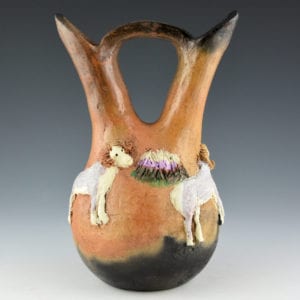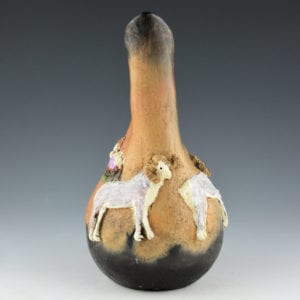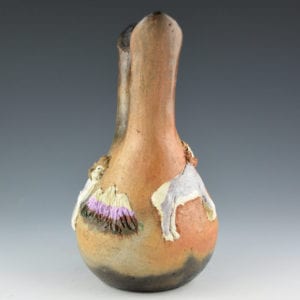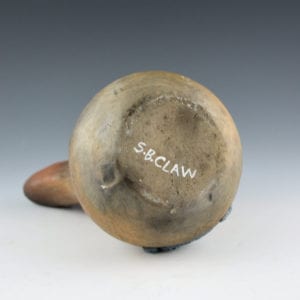Photographs courtesy of King Galleries. Click on image to expand.
Base is 5.0 ” wide.
If big-horned sheep go to heaven, this is what their afterlife must look like. Mountain ranges float by like clouds; slightly-purple sheep graze nearby. You can’t get more folk-arty than this.
As a teenager I climbed mountains in Colorado and Wyoming and once caught a glimpse of big horned sheep. This vase does not reproduce exact details of these animals, but rather is reductive — sort of like my memory of the encounter 60 years ago. I can’t remember what mountain I was on or even what state I was in at the time, but I clearly remember the awe of being allowed to share space with such creatures. Great folk art is like that: it’s an evocative simplification, often a narrative.
The clay for the vase was dug near Cow Springs and the Claws gathered prehistoric pottery shards from near Tuba City and ground them to use as temper. The Claws made pottery as a team. Bertha formed the couple’s vessels using a ceramic bowl covered with vaseline to shape and support the base and building up coils of clay for the body. Silas formed and painted the appliqué figures (Dobbins and Russell, 2007:60-61).
This vase is thick-walled and thus heavy for its size. This shape was a favorite of Bertha and she was skilled at shaping her clay; wedding vase 2020-01 is well-formed. The vase was dried and fired in a wood-burning stove in their home (Dobbins and Russell, 2007:61). As is typical of Navajo pottery, the firing left patches of dark clouds, in this case on the handle and the lower portion of the pot.
The couple began making pots for sale in the mid-1960’s. From the mid 1980’s until his death in 2002, Silas applied a great variety of appliqué figures to their pottery. Figures from this period represent both the sacred mythology of his Navajo culture and the secular myths of Anglo culture: sacred Ye’ii to Halloween witches and Pocahontas, for example. He decorated these figures with bright acrylic paint, either before or after covering the vase with marine varnish, a substitute for the traditional coat of pinion pitch.
“The inspiration to paint was Silas’s and the technique was unique among Navajo potters (Dobbins and Russell, 2007:60).”
Vase 2020-01 was made in the early 1990’s
On vase 2020-01 Silas has sculpted three big-horned sheep. Each is slightly different, but all have prominent brown horns, white faces, chests, bellies and tails. Their backs and legs are light purple. Two black dots mark the eyes; a small incision indicates their mouths. Adding perspective to the diorama, two small mountain ranges float between the large sheep, Ecologically correct, the mountains are green at the bottom and then brown and purple before culminating in snow-covered peaks.
There are wild and powerful big horned sheep and winsome, whimsical big horned sheep. The sheep on this jar belong to the latter species.. The Rocky Mountains are awesome; here they look like ice cream cakes at Baskin Robbins. The firing smudges below the feet of the sheep look like clouds, a tipoff that we are in a dream world. This is Navajo folk art at its best: impactful and full of humor. Such art is a relatively new creation.
Traditional Navajo pottery is utilitarian and plain (cf 1969-07) and its production declined with the arrival of Anglo trading posts on the reservation during the last quarter of the 19th century. Anglo metal pots replaced clay vessels for household use. Writing of the Navajo in 1893, Alexander Stephen wrote:
“The older women still make cooking utensils of pottery, but the younger ones no longer practice the art. The iron camp kettles and tin cups…brought in by the traders are rapidly displacing…earthen jars (quoted in Tschopik, 1941:47).”
Sixty years later Bill Beaver, an Anglo trader, reported from Shonto Trading Post in Tonalea, AZ that a few women in his corner of the Navajo reservation were still making pottery:
“We have encouraged the traditional styles and hope that the craft (of pottery making) will not go commercialized like that of so many of the pueblos in recent years….Navajo pottery…doesn’t have the appeal that would make it a tourist commodity and so the quantity produced will always be small…Navajo pottery is not completely dead, nor will it be dead in the Shonto area for a few years to come (1952:109).”
Shonto is in the northwest region of the Navajo reservation, has good clay deposits, and was one of the few places where Navajo pottery was produced (mostly for ceremonial use) in the 1950’s. However, within ten years of Beaver’s writing, the construction of Glen Canyon Dam and thus Lake Powell nearby brought new roads and tourists to the area and triggered new economic opportunities for the Navajo people.
Silas Claw was born sometime between 1911 and 1915. His wife Bertha Claw was born in 1926. SIlas attended an off-reservation boarding school and learned to speak English well; Bertha speaks only Navajo. They lived near Shonto and Cow Springs on the reservation and lived traditional lives raising sheep with Silas also working manual jobs off the reservation. Responding to the influx of tourists, Bertha learned to form pottery from relatives. Silas taught himself and only his signature appears on the couple’s pots.
Living in a sparse natural environment, rooted in a rich Native heritage that was threatened by a dominant Anglo culture, the Silases turned these factors into resources for income, art and humor.






